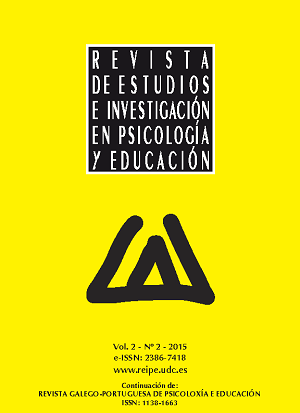Prueba de cribado de expresión escrita en gallego para escolares de segundo de Enseñanza Primaria || Test of written expression in Galician for students of second grade
DOI:
https://doi.org/10.17979/reipe.2015.2.2.657Palabras clave:
expresión escrita, evaluación de la escritura, dificultades en escritura, gallegoResumen
En este trabajo presentamos una prueba para detectar las dificultades en expresión escrita en gallego para escolares de segundo de Educación Primaria (EXEGA2), atendiendo tanto al contenido como a algunos aspectos superficiales. Dicha prueba forma parte de una batería de instrumentos más amplia, en castellano y gallego, que tiene como objetivo evaluar el rendimiento en lectura y escritura al inicio de ese curso académico. Se describe el marco teórico de partida, el proceso seguido para la elaboración de la misma, sus principales características y algunos resultados obtenidos. La aplicación de EXEGA2 puede ofrecer datos útiles de cara a la intervención.
Descargas
##plugins.generic.pfl.publicationFactsTitle##
##plugins.generic.pfl.reviewerProfiles## N/D
##plugins.generic.pfl.authorStatements##
Indexado: {$indexList}
-
##plugins.generic.pfl.indexedList##
- ##plugins.generic.pfl.academicSociety##
- N/D
- Editora:
- Universidade da Coruña, Servizo de Publicacións
Citas
Alvarado, M. (1988). La digrafía escolar: Escala disgráfica. Tratamientos correctivos. Alicante: Disgrafos.
Barton, D. (1994). Literacy. An Introduction to the Ecology of Written Language. Oxford: Blackwell.
Björk, L. & Blomstrand, I. (2000). La escritura en la enseñanza secundaria. Los procesos del pensar y del escribir. Barcelona: Graó.
Britton, J. N., Martin, N. C. & Rosen, H. (1966). Multiple Marking of English Compositions. An account of an experiment. London: The School Council.
Camps, A. & Ribas, T. (2000). La evaluación del aprendizaje de la composición escrita en situación escolar. Madrid: MECD/CIDE.
Cassany, D. (1999). Construir la escritura. Barcelona: Paidós.
Corbett, P. (2001). How to teach fiction writing at Key Stage 2. London: David Fulton.
Cuetos, F., Ramos, J. L. & Ruano, F. (2002). PROESC. Evaluación de los procesos de escritura. Madrid: TEA.
Fehring, F. (2003). Understanding the influences on teachers´ judgements in the process of assessing and reporting students´ literacy in the classroom. En H. Fehring (Ed.). Literacy Assessment. A Collection of Articles From de Australian Literacy Educators´Association (pp. 9-31). Newark, DE: International Reading Association.
Ferreiro, E., Pontecorvo, C., Ribeiro, N. & García, I. (1996). Caperucita Roja aprende a escribir. Estudios psicolingüísticos comparativos en tres lenguas. Barcelona: Gedisa.
Indrisano, R. & Paratore, J. R. (2005). Learning to Write. Writing to Learn. Theory and Research in Practice. Newark, DE: International Reading Association.
Outón, P. (2004). Programas de intervención con disléxicos. Madrid: CEPE.
Outón, P. & Abal, R. (2013). Diagnostic assessment and treatment of Reading difficulties: A case study of dislexia. US-China Education Review B, 5, 305-312.
Salinger, T. (1998). Consequential validity of an early literacy portfolio: the “backwash”reform. En C. Harrison & T. Salinger (Eds.). Assessing reading, 1: theory and practice. London: Routledge.
Santibáñez, J. & Sierra, J. (1989). La evaluación de la escritura. Test de Escritura para el Ciclo Inicial T.E.C.I. Madrid: CEPE.
Secadas, F., Rodríguez, M. T. & Alfaro, I. (1994). Escribir es fácil, I-II. Madrid: TEA Ediciones.
Shiel, G. & Murphy, R. (1999). Development of Coherence and Structure in Irish Children´s Writing: Implications for Assessment and Instruction. Paper presented at the 11th European Conference on Reading, Stavanger, Norway, August 1-4, 1999.
Suárez, A. (1995). Dificultades en el aprendizaje. Un modelo de diagnóstico e intervención. Madrid: Santillana.
Suárez, A. (2002). Las faltas de ortografía en su sitio. La Voz de Galicia, 19 de septiembre del 2002.
Thorndyke, P. W. (1977). Cognitive Structures and Memory of Narrative Discourse. Cognitive Psychology, 9, 77-110.
Valencia, Sh. W., Hiebert, E. H., & Afflerbach, P. P. (1994). Authentic Reading Assessment: Practices and Possibilities. Newark, DE: International Reading Association.
Descargas
Publicado
Cómo citar
Número
Sección
Licencia
Los trabajos publicados en esta revista están bajo una licencia Creative Commons Reconocimiento-CompartirIgual 4.0 Internacional.
Los/as autores/as son los titulares de los derechos de explotación (copyright) de su trabajo, pero ceden el derecho de la primera publicación a la Revista de Estudios e Investigación en Psicología y Educación, la cual podrá publicar en cualquier lengua y soporte, divulgar y distribuir su contenido total o parcial por todos los medios tecnológicamente disponibles y a través de repositorios.
Se permite y anima a los/as autores/as a difundir los artículos aceptados para su publicación en los sitios web personales o institucionales, antes y después de su publicación, siempre que se indique claramente que el trabajo está en esta revista y se proporcionen los datos bibliográficos completos junto con el acceso al documento, preferiblemente mediante el DOI (en caso de que sea imprescindible utilizar un pdf, debe emplearse la versión final maquetada por la Revista). En el caso de artículos que provengan de estudios o proyectos financiados, esto se hará en los plazos y términos establecidos por la entidad o entidades financiadoras de la investigación publicada.




